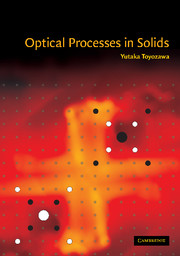Book contents
- Frontmatter
- Contents
- Preface
- Acknowledgments
- List of principal symbols
- 1 Radiation field
- 2 Quantum mechanics
- 3 Interaction of radiation with matter
- 4 Electronic vs. nuclear motions and the optical spectra of localized electrons in solids
- 5 Lattice vibrations
- 6 Electric susceptibility and dielectric constant
- 7 One-electron states in solids
- 8 Excitons
- 9 Polaron and the self-trapped state
- 10 Optical spectra of exciton in the phonon field Overview
- 11 Higher-order optical processes
- 12 Inner-shell excitation
- 13 Photo-induced structural changes
- 14 Light, matter and life (A scenario for the origin of life and its evolution)
- Appendix 1 Derivation of exciton Hamiltonian from many-body Hamiltonian
- Appendix 2 Transient spectra for second-order optical processes
- References (by chapter)
- Subject index
2 - Quantum mechanics
Published online by Cambridge University Press: 10 December 2009
- Frontmatter
- Contents
- Preface
- Acknowledgments
- List of principal symbols
- 1 Radiation field
- 2 Quantum mechanics
- 3 Interaction of radiation with matter
- 4 Electronic vs. nuclear motions and the optical spectra of localized electrons in solids
- 5 Lattice vibrations
- 6 Electric susceptibility and dielectric constant
- 7 One-electron states in solids
- 8 Excitons
- 9 Polaron and the self-trapped state
- 10 Optical spectra of exciton in the phonon field Overview
- 11 Higher-order optical processes
- 12 Inner-shell excitation
- 13 Photo-induced structural changes
- 14 Light, matter and life (A scenario for the origin of life and its evolution)
- Appendix 1 Derivation of exciton Hamiltonian from many-body Hamiltonian
- Appendix 2 Transient spectra for second-order optical processes
- References (by chapter)
- Subject index
Summary
Elements of quantum mechanics
Quantum mechanics was discovered in 1925 through groping efforts to compromise two apparently contradictory pictures on the fundamental entities in nature. One was the wave picture for light which was later extended to matter by de Broglie, another was the corpuscular picture of matter which was later extended to light by Einstein. Schrödinger's wave equation came as a natural development of the first stream, while Heisenberg's matrix mechanics was presented as a unique proposal from the second stream. In spite of completely different appearances, the two theories proved, within a couple of years after their discoveries, to be equivalent. This is a most beautiful example that the physical reality exists independent of the mathematical framework formulated for its description.
In this chapter, we will give a very brief review of the principles of quantum mechanics,1–3 mainly with the harmonic oscillator as a model system for the following reasons. The first is historical: the electromagnetic wave, whose interaction with matter is the subject of this book, is a harmonic oscillator, a system which was for the first time subject to “quantization”, thus opening a way to the discovery of quantum mechanics. The second is technical: the harmonic oscillator is one of very few examples of analytically soluble problems in quantum mechanics. The third is pedagogical: the harmonic oscillator is a system best suited for realization of the equivalence of the two different pictures mentioned above and hence for a deeper understanding of the principles of quantum mechanics.
- Type
- Chapter
- Information
- Optical Processes in Solids , pp. 10 - 27Publisher: Cambridge University PressPrint publication year: 2003

